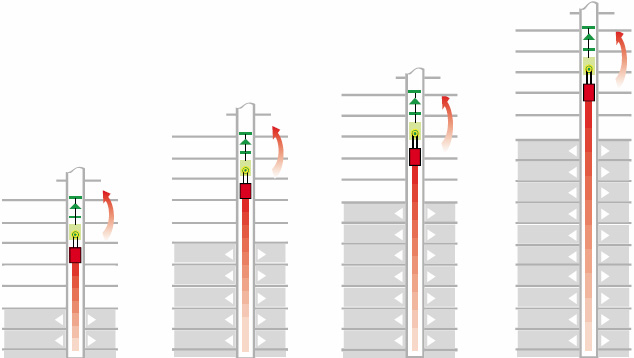Elevator and escalator manufacturer KONE Inc. announced the first North American installation of the company's JumpLift technology. The system is being implemented on the One Bloor project, Great Gulf’s flagship high-rise condominium under construction in Toronto.
KONE JumpLift, which has already been installed in Europe, Asia, the Middle East, China, and Australia, is an advanced, self-climbing elevator that operates during construction in a building’s permanent hoistway. JumpLift uses a mobile machine room that moves upward as the construction progresses.
The technology can improve safety and efficiency on job sites and can enable buildings to be completed months ahead of traditional construction timelines.
Great Gulf and KONE are collaborating on the project, which will deliver high-end retail and residential units in Toronto’s Bloor-Yorkville area, and is expected to be completed in 2016.
The KONE JumpLift technology includes the following benefits:
• Less wait time: Operating at speeds up to 800 fpm (4m/s), five times faster than a traditional external hoist used in construction, KONE JumpLift is able to move construction workers to their floors in a faster, safer way.
• Safer transportation: With all transportation activities taking place inside in a dry and windproof shaft, construction workers can safely move throughout the building regardless of weather conditions, allowing building construction to proceed unhindered.
• Construction efficiency: Using the building’s permanent elevator hoistway for construction use, completed floors can be put into action while allowing the installation to continue above.
• Faster delivery: When the building structure is completed, changing over to the permanent elevator is a straightforward matter of installing the final machinery and finishing the material surfaces of the elevator car, landing doors and signalization.
“Great Gulf always looks for innovation in design and construction. One Bloor, recently recognized by the International Property Awards as the best hi-rise condominium in North America, is one of the most significant buildings being built in Toronto,” said Christopher Wein, President Great Gulf Residential. “The KONE JumpLift provides real value and this elevator technology will help the entire construction project to proceed more efficiently and safely for everyone working on site.”
Related Stories
| May 10, 2011
Solar installations on multifamily rooftops aid social change
The Los Angeles Business Council's study on the feasibility of installing solar panels on the city’s multifamily buildings shows there's tremendous rooftop capacity, and that a significant portion of that rooftop capacity comes from buildings in economically depressed neighborhoods. Solar installations could therefore be used to create jobs, lower utility costs, and improve conditions for residents in these neighborhood.
| Mar 10, 2011
Taking ‘PIM’ Beyond E-mail
Newforma enhances its Project Center information management platform with a Revit add-in’ and mobile capability.
| Feb 10, 2011
Medical Data Center Sets High Bar for BIM Design Team
The construction of a new data center becomes a test case for BIM’s ability to enhance project delivery across an entire medical campus.
| Feb 10, 2011
Zero Energy Buildings: When Do They Pay Off in a Hot and Humid Climate?
There’s lots of talk about zero energy as the next big milestone in green building. Realistically, how close are we to this ambitious goal? At this point, the strategies required to get to zero energy are relatively expensive. Only a few buildings, most of them 6,000 sf or less, mostly located in California and similar moderate climates, have hit the mark. What about larger buildings, commercial buildings, more problematic climates? Given the constraints of current technology and the comfort demands of building users, is zero energy a worthwhile investment for buildings in, for example, a warm, humid climate?
| Jan 28, 2011
Firestone Building Products Unveils FirestoneRoof Mobile Web App
Firestone Building Products Company unveiled FirestoneRoof, a first-of-its-kind free mobile web app. The FirestoneRoof mobile web app enables customers to instantly connect with Firestone commercial roofing experts and is designed to make it easier for building owners, facility managers, roofing consultants and others charged with maintaining commercial roofing systems to get the support they need, when they need it.
| Jan 25, 2011
Bloomberg launches NYC Urban Tech Innovation Center
To promote the development and commercialization of green building technologies in New York City, Mayor Michael R. Bloomberg has launched the NYC Urban Technology Innovation Center. This initiative will connect academic institutions conducting underlying research, companies creating the associated products, and building owners who will use those technologies.
| Jan 19, 2011
Large-Scale Concrete Reconstruction Solid Thinking
Driven by both current economic conditions and sustainable building trends, Building Teams are looking more and more to retrofits and reconstruction as the most viable alternative to new construction. In that context, large-scale concrete restoration projects are playing an important role within this growing specialty.
| Jan 4, 2011
6 green building trends to watch in 2011
According to a report by New York-based JWT Intelligence, there are six key green building trends to watch in 2011, including: 3D printing, biomimicry, and more transparent and accurate green claims.
| Jan 4, 2011
LEED standards under fire in NYC
This year, for the first time, owners of 25,000 commercial properties in New York must report their buildings’ energy use to the city. However, LEED doesn’t measure energy use and costs, something a growing number of engineers, architects, and landlords insist must be done. Their concerns and a general blossoming of environmental awareness have spawned a host of rating systems that could test LEED’s dominance.
| Dec 17, 2010
New engineering building goes for net-zero energy
A new $90 million, 250,000-sf classroom and laboratory facility with a 450-seat auditorium for the College of Electrical and Computer Engineering at the University of Illinois at Urbana/Champaign is aiming for LEED Platinum.















